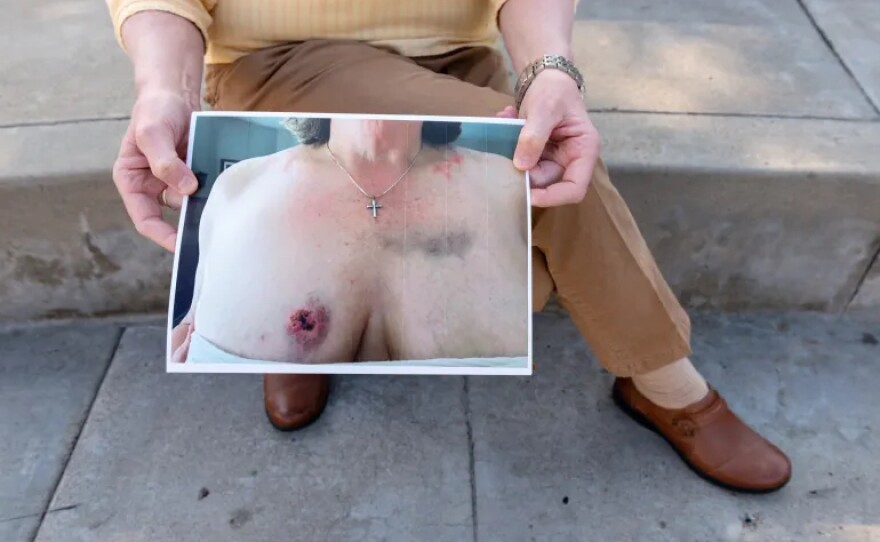Emergency rooms are places for medical care but, for some doctors and nurses, they can also be a battleground. Violence against health care workers is on the rise. Federal data show they are five times more likely to experience workplace violence than employees in other professions.
Dr. Clay Whiting has spent more than 20 years in emergency medicine at Scripps Mercy Hospital. He said he’s been attacked multiple times.
“We deal with pretty much the highest levels of stress that, you know, people experience in the workplace,” Whiting said. “And so I've learned, you know, over time, just the importance of, you know, self-care and making sure that I come in with the right mindset each and every shift.”
For Whiting, that mindset was tested five years ago when a patient suddenly attacked him inside the ER at the start of his shift.
“All of a sudden a patient stood up on the bed and jumped on top of me, crashed into the doors, landing on the ground, before I knew it. And now I have someone physically on top of me, standing over me, literally throwing punches at my face and my head,” he said.
Whiting is far from alone. A 2024 poll from the American College of Emergency Physicians found that more than 90% of ER doctors were threatened or attacked in the previous year. Even when incidents are reported, Whiting said accountability is rare.
“There was a formal complaint that was filed. However, nothing really came of it,” Whiting said. “The time that it took to go down and actually go before the courts and try to have people held accountable. It just kind of continued to prevent you from moving on.”
For some health care workers, the risk of violence has driven them to leave the profession entirely. Data gathered in 2023 by a labor union for registered nurses — National Nurses United — found 6 in 10 nurses report workplace violence has made them quit, change jobs, or think about leaving the profession.
“There definitely have been healthcare workers at this facility that have left the hospital because they’ve been attacked to the point where they have PTSD and they're afraid to take care of patients,” Whiting said.

In 2018, former Scripps nurse Mary Prehoden was attacked by a schizophrenic patient off his medication. He bit her so hard he left a bite-shaped scar on her chest.
Now, California is taking action. A new law that went into effect in January, Assembly Bill 977, increases jail time for people who assault ER workers from six months to one year and raises penalties to up to $2,000.
Violence in hospitals ranges from verbal abuse to brutal attacks according to Todd Walbridge, a former FBI agent who is now head of security at Scripps Health.
“Using hospital medical equipment as weapons to punching, kicking, spitting, grabbing, hair pulling,” Walbridge said.
But he said hospitals are working to reduce those incidents.
“This year, we were able to reduce hospital violence by 31%. It had been on the rise for three years prior to that,” he said.
Hospitals have ramped up training efforts, teaching staff how to recognize early signs of aggression and intervene before situations escalate.
“It’s a combination of de-escalation training, self-defense training, and working with patients to try to identify people who are on a trajectory toward violence and begin the de-escalation process sooner rather than later,” Walbridge said.
Security measures are also increasing. Some hospitals have installed metal detectors, and security officers now wear body armor and carry tasers. Scripps Health is rolling out a visitor registration system to track everyone who enters its facilities.

Christine Basiliere oversees security at Sharp HealthCare. She said working in medicine comes with risks. While the new law is meant to protect health care workers, she’s worried it could have unintended consequences for patients in crisis.
“What I wouldn't want is for the Assembly Bill to cause further harm to people that maybe are having a mental health crisis, or going through a severe withdrawal, or have a brain injury or do something while they're in extreme pain,” Basiliere said.
She stressed that intent matters, especially when dealing with patients in highly complex medical situations.
Violence against health care workers prompted Scripps CEO Chris Van Gorder to form the San Diego Hospital Workforce Violence Task Force in 2023. Since then, the task force has introduced several initiatives to help staff pursue charges, hold offenders accountable, and seek justice. One such effort, developed in partnership with the San Diego County District Attorney’s office, is a list of resources designed to assist employees in navigating the legal process.
Whiting said no charges were filed against the man who attacked him five years ago. This new law is a long-overdue step toward justice, he said.
“I think that it will help health care workers feel that … if, and unfortunately, when we are attacked, that maybe some real justice can occur,” he said.
Walbridge said the law, which charges assaults as misdemeanors, falls short.
“What we would have liked to have seen was a felony for everyone in the hospital who was assaulted. That’s the equivalent to what happens to an emergency worker outside the hospital,” he said.
The law only applies to assaults inside the emergency room. Violence in other hospital areas is still treated as a lesser crime.
Despite the risks, many ER workers, including Whiting, remain committed to their jobs.
“When I begin each shift, I think it's important that the message that I try to convey and bring to the bedside is that I'm here to try to listen, help and heal,” he said. “I'm not here to judge.”






